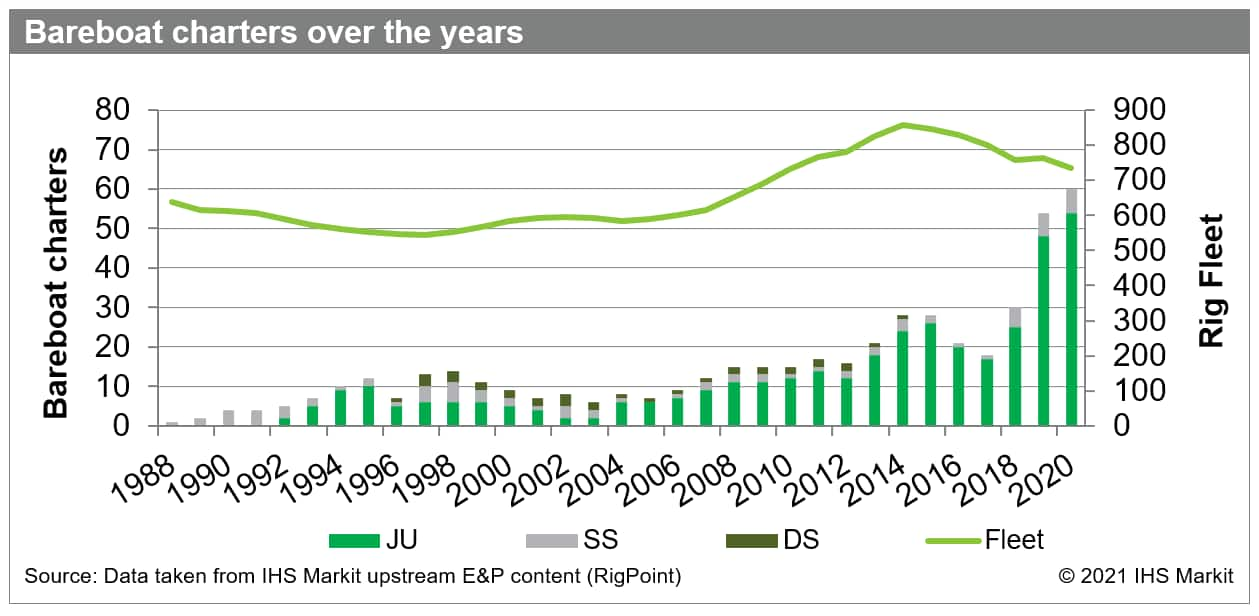Customer Logins
Obtain the data you need to make the most informed decisions by accessing our extensive portfolio of information, analytics, and expertise. Sign in to the product or service center of your choice.
Customer Logins
BLOG
Apr 30, 2021
Bareboat charters: An unexpected solution for the newbuild rigs glut
For decades, most international offshore contractors have built their fleets by taking on financing to acquire rigs or order them from scratch. If they do not have a suitable rig to meet a potential demand, the option to do so by bareboat chartering one - that is, to lease a 'bare' unit without crew or provisions, and to assume responsibility for someone else's asset - is seldom considered. Nor do these firms usually bareboat their rigs to others.
But as offshore financing dried up in the last few years, and
contractors struggle to survive while yards pile up with unwanted
newbuilds, one trend has become clear of late: more offshore rigs
are being put to work on the back of bareboat arrangements. These
days, the cart can come before the horse: some firms chase the work
first, by offering units they do not own; and only when they win
the tender, do they seal the deal and lease the rig to fulfil the
contract.

Figure 1: Bareboat charters over the years
The chart above shows the number of rigs on bareboat charter every
year over the last three decades. It includes units that may have
been bareboat for only part of a year, but most were on contract
for at least a year or longer. As the global drilling fleet grew
since 1988, the proportion of rigs on bareboat charters has also
increased progressively - from 0.2% of the fleet in 1988, to 2.5%
in 1998, 3.3% in 2014, and 8.1% in 2020.
It is clear from the chart that the majority of the units with
bareboat arrangements are jackups but this is not surprising as
floaters are more expensive than jackups, whether to build,
maintain, or charter. The terms for bareboat contracts, though, can
vary widely. Under some arrangements, the charterer or leasee has
to pay a fee only when the rig is working. Some have their units
chartered based on a monthly rate, while yet others are under
lumpsum agreements.
Sale-and-leaseback deals have also been a feature since the late
2000s. Under these agreements, rig owners would sell and then lease
back their rigs from the purchasers - allowing them to free up cash
while holding on to the assets they need for operation. In 2019,
Singapore yard Keppel FELS delivered newbuild jackups Cantarell III
and Cantarell IV to Grupo R, then bought the rigs from the Mexican
contractor before leasing them right back for 10 years. This way,
though the yard now effectively becomes a lender to a customer who
could no longer afford to own the jackups it ordered, it monetised
the assets and got the rigs working.
Historical data points show that bareboat fees are usually at least
10% of prevailing drilling day rates. With the rig market in the
doldrums, bareboat prices have also fallen as the market bottomed
out. Currently, fees for jackups range between USD 10,000 and USD
30,000 per day. Factors like job scope, rig age, state of the unit
and other specifications can also affect the price.
Location is another determinant. Early on, the few rigs on bareboat
charters worked mostly in Europe or in the Gulf of Mexico. This has
changed over the years. In 2020, the top three areas to feature
bareboat rigs are Asia-Pacific with 24 units, the Middle East with
19 units, and Mexico with 11. At present, Asia-Pacific is the
region with the largest bareboat fleet and the bulk of these units
are located in China - in 2020, 17 of the 24 units in Asia were
based there.
Building a fleet with bareboat rigs
An interesting facet of the recent increase in bareboat numbers is
how newbuilds are driving it. In 2017, just three of the 18 units
bareboat worldwide were mobilised straight from a yard. In 2018, it
was two. By 2019, this jumped to 24, or well over a third of the 54
units on bareboat charter that year. In 2020, although just seven
of the 60 bareboat units worldwide were newbuilds, 35 of them were
built within the last four years.
However, it is no coincidence that newbuild bareboat numbers rose
so dramatically in 2019 - that was the year SinoOcean was set up.
Since the last offshore downturn in 2014, China - the rig-building
powerhouse of the last decade - was quickly becoming a graveyard
for undelivered rigs. The state-owned entity was conceived to
manage offshore assets abandoned by their original buyers, working
behind the scenes to seek solutions for orphaned rigs. So far,
China's leading offshore rig contractor COSL is the one that has
taken on the bulk of Chinese newbuilds via bareboat arrangement. Of
the 58 offshore rigs it operates worldwide, at least 22 jackups and
semis are managed under bareboat contracts.
There is no doubt bareboat charters are a means for the industry to
cope with existing market conditions. It is a certainly a cheaper
option than ownership for contractors and other enterprising
middlemen to secure rigs. Not to mention the unexpected bonus of
bareboat charters having helped to ease the oversupply situation by
winnowing the number of undelivered rigs from over 120 units in
2018 to 60 today.
Yun Yun Teo is a data transformation principal for upstream energy at IHS Markit.
Posted 30 April 2021
This article was published by S&P Global Commodity Insights and not by S&P Global Ratings, which is a separately managed division of S&P Global.
{"items" : [
{"name":"share","enabled":true,"desc":"<strong>Share</strong>","mobdesc":"Share","options":[ {"name":"facebook","url":"https://www.facebook.com/sharer.php?u=http%3a%2f%2fprod.azure.ihsmarkit.com%2fcommodityinsights%2fen%2fci%2fresearch-analysis%2fbareboat-charters-an-unexpected-solution-for-the-newbuild-rigs.html","enabled":true},{"name":"twitter","url":"https://twitter.com/intent/tweet?url=http%3a%2f%2fprod.azure.ihsmarkit.com%2fcommodityinsights%2fen%2fci%2fresearch-analysis%2fbareboat-charters-an-unexpected-solution-for-the-newbuild-rigs.html&text=Bareboat+charters%3a+An+unexpected+solution+for+the+newbuild+rigs+glut++%7c+S%26P+Global+","enabled":true},{"name":"linkedin","url":"https://www.linkedin.com/sharing/share-offsite/?url=http%3a%2f%2fprod.azure.ihsmarkit.com%2fcommodityinsights%2fen%2fci%2fresearch-analysis%2fbareboat-charters-an-unexpected-solution-for-the-newbuild-rigs.html","enabled":true},{"name":"email","url":"?subject=Bareboat charters: An unexpected solution for the newbuild rigs glut | S&P Global &body=http%3a%2f%2fprod.azure.ihsmarkit.com%2fcommodityinsights%2fen%2fci%2fresearch-analysis%2fbareboat-charters-an-unexpected-solution-for-the-newbuild-rigs.html","enabled":true},{"name":"whatsapp","url":"https://api.whatsapp.com/send?text=Bareboat+charters%3a+An+unexpected+solution+for+the+newbuild+rigs+glut++%7c+S%26P+Global+ http%3a%2f%2fprod.azure.ihsmarkit.com%2fcommodityinsights%2fen%2fci%2fresearch-analysis%2fbareboat-charters-an-unexpected-solution-for-the-newbuild-rigs.html","enabled":true}]}, {"name":"rtt","enabled":true,"mobdesc":"Top"}
]}

